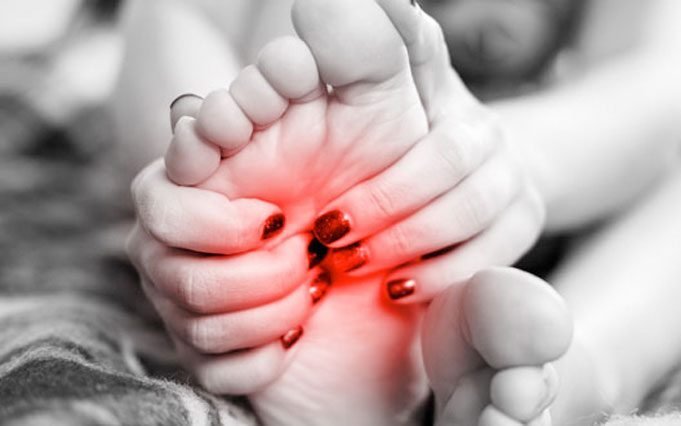Metatarsalgia
Pain on the Ball of the Foot

Metatarsalgia literally translates to “Pain on the ball of the foot”. There are several types of metatarsalgia, but they generally are caused by the same thing – pressure and overuse. This leads to pain and inflammation of the structures of the forefoot area (ball of the foot). The structures involved can be the joint capsule (capsulitis), the bursa (bursitis), the flexor tendons (tendinitis), the nerves (neuritis) etc.
Symptoms
- Pain or burning
- Feels like you’re stepping on a marble or pebble
- Feels like bruising
- Footwear – Worn out footwear, flats, flip flops
- Weight – Being overweight puts extra stress on the forefoot area
- Foot Type – Flat feet and high arched feet. A flat foot (overpronation) creates more friction in the forefoot area. High arched feet often lack shock absorption, increasing ground reaction forces to the forefoot area.
- Tight Calf Mucles – Tight calf muscles force the foot downward, increasing forefoot loads.
- Underlying conditions like rheumatoid arthritis, and diabetes.
- Foot deformities such as hammer toes or claw toes increases forefoot pressures.
- Age – The protective fat pad under the ball of the foot thins and migrates forward with age.
Treatment
While there are several effective treatments for plantar fasciitis, there is no “silver bullet” treatment. We suggest layering multiple treatments for best results.
- Rest – Rest is an essential step in recovery. You will need to decrease or stop activities that cause the pain. Activities such as running, walking, stair climbing, and jumping are particularly aggravating. Swimming and biking are good low impact alternatives. Many people are disappointed that they cannot participate in an activity they are passionate about during this time. Just remember that you will get back to that activity faster if you rest and heal now.
- Structured Running Shoes – Good cushion and support are vital. Your runners need to be fairly new and of high quality so there is plenty of cushion. The midsole (cushioned area) of your shoes wears out after 6-12 months depending on use. The best types of shoes for your foot will be recommended based on the biomechanical assessment performed at the clinic. Home footwear is equally as important during the healing process. Avoid flats, “skate shoes”, flip flops and other low-cushioned footwear.
- Custom Orthotics or Off-The-Shelf Inserts – These products offload the painful area. They may incorporate a “metatarsal pad” and/or a forefoot “sweet spot”, both of which direct pressure away from the painful area. The better the orthotic contours to the foot, the more it will reduce load to the painful area on the ball of the foot.
- Offloading – A chiropodist can apply a custom made felt pad in a specific manner to offload the painful area.
- Calf Stretching – Stretching the calf muscles reduces forefoot loads
- Low Level Laser Therapy – This treatment offered in-clinic helps reduce pain, inflammation and speed up healing.
- Medications – Anti-inflammatory medication can help manage pain and inflammation.
Non-Resolving Cases
- Corticosteroid Injections – Performed by a chiropodist. Corticosteroid injections to the affected structure help to reduce pain and inflammation.
- Immobilization – Sometimes complete rest via immobilization is needed. 4-6 weeks in an air cast may facilitate this.
Prevention
To prevent recurrence, it is important to wear good quality shoes recommended by your chiropodist. Use house shoe/slipper with sufficient cushion. Use custom orthotics consistently if prescribed. Continue with basic calf stretching long term to reduce forefoot stress.
